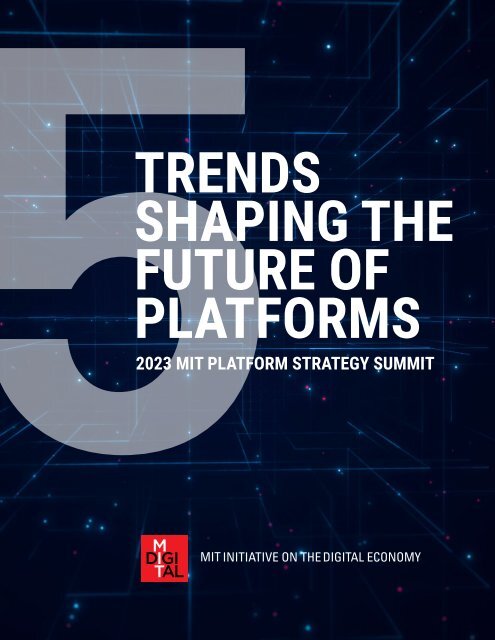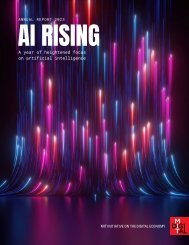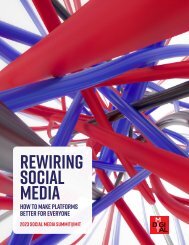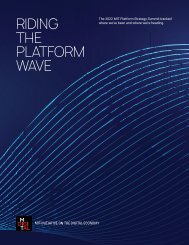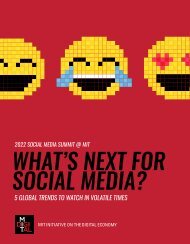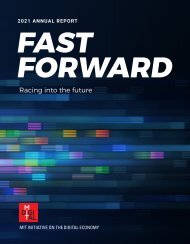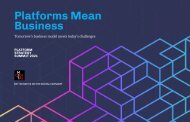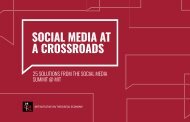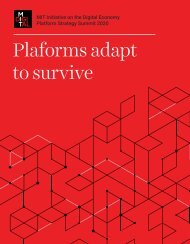2023 MIT Platform Strategy Summit Report
You also want an ePaper? Increase the reach of your titles
YUMPU automatically turns print PDFs into web optimized ePapers that Google loves.
TRENDS<br />
SHAPING THE<br />
FUTURE OF<br />
PLATFORMS<br />
<strong>2023</strong> <strong>MIT</strong> PLATFORM STRATEGY SUM<strong>MIT</strong>
WHAT’S NEXT?<br />
CONTENTS<br />
04 Trend #1: The Impact of AI<br />
Opportunities abound with artificial intelligence, including<br />
improvements to human-machine collaboration. But serious<br />
challenges loom as well, including hidden bias, labor challenges,<br />
even the possible evolution of a new species.<br />
08 Trend #2: Circular <strong>Platform</strong>s<br />
The circular economy aims to mitigate pollution and climate<br />
change with supply chains designed for reuse, repair, redesign,<br />
and recycling. <strong>Platform</strong>s are the infrastructure girding product<br />
and materials exchanges, reuse marketplaces, sharing sites,<br />
circular suppliers’ networks, and sustainable logistics collectives.<br />
12 Trend #3: The Role of Regulation<br />
As platforms gain clout, they also attract new regulatory<br />
oversight. <strong>Summit</strong> panelists explained the sharply divergent<br />
approaches in the United States and Europe.<br />
Co-chair Geoffrey Parker welcomes attendees, along with (from<br />
left) Annabelle Gawer, Peter C. Evans, and Marshall Van Alstyne.<br />
16 Trend #4: Connected Manufacturing<br />
A new wave of platform-based companies are using<br />
manufacturing data to help them run smarter factories and<br />
better forecast supply and demand.<br />
20 Trend #5: Influencers & the Creator Economy<br />
The Creator Economy has an estimated total value of $100<br />
billion, accounting for up to 40% of the overall digital marketing<br />
spend. Some social-media influencers are even getting hired by<br />
big brands.<br />
24 Conversation: Freeing Up <strong>Platform</strong> Investments<br />
Scott Sandell, head of venture-capital firm NEA, offers novel<br />
advice for platform entrepreneurs and investors: Give it away.<br />
Look for the<br />
icon to watch full sessions<br />
As platforms strengthen and gain clout, models<br />
must continue to evolve and adapt<br />
A decade after the first <strong>MIT</strong> <strong>Platform</strong> <strong>Summit</strong>, today’s interconnected<br />
ecosystems show no signs of slowing down. In fact, digital platforms have<br />
intensified their position as a transformational force within businesses<br />
and externally to customers and industry partners. Most notably they have<br />
permanently changed social transactions—think social media, entertainment,<br />
and collaboration.<br />
The global online platform universe is ubiquitous, but it also faces some<br />
tough challenges including value creation, labor issues, antitrust,<br />
misinformation, and government regulation. The sudden advancements of<br />
AI are taking center stage, as well.<br />
All of these topics were featured on July 13 at the <strong>2023</strong> <strong>MIT</strong> <strong>Platform</strong> <strong>Strategy</strong><br />
<strong>Summit</strong>, held online and in person at <strong>MIT</strong>. Expert speakers —from academia,<br />
government, industry, and nonprofits—engaged more than 300 attendees in a<br />
day of debate and recommendations. Looking to the future of the platform<br />
economy, speakers focused on five key trends: AI, sustainability, regulation,<br />
manufacturing, and the creator economy.<br />
<strong>Summit</strong> co-chairs Peter C. Evans, chief strategy officer of McFadyen Digital,<br />
Geoffrey Parker of Dartmouth College, and Marshall Van Alstyne of Boston<br />
University, along with Annabelle Gawer, a professor at the University of Surrey,<br />
explained how platforms will be pivotal to all of these disruptions. Parker sees<br />
a “super-dynamic” environment for platforms going forward, while Evans noted<br />
that the future of platforms will be “multidimensional.”<br />
The co-chairs said that new technologies and models are infusing platforms<br />
with new energy and ideas. Chief among them, according to Evans, are<br />
platform-based responses to climate change and the circular economy. Van<br />
Alstyne is hopeful that as platforms evolve they will bring better social and<br />
economic outcomes to the world.<br />
Gawer is optimistic as well, but she added some caveats: “When we as a<br />
community started to work on platforms…the mood was extremely optimistic,<br />
some might even say utopian.” But now, she said, “we need to take a harder<br />
and more lucid look into what platforms have achieved—not just in terms of<br />
good, but also in terms of bad.” Responsible self-governance and trust will be<br />
essential to maintaining the positive impacts of platforms, she said.<br />
The sentiments of <strong>Summit</strong> speakers ranged from extreme optimism about<br />
platforms for manufacturing and sustainability, to extreme concern about<br />
the risks of unchecked artificial intelligence. But all agreed that platforms will<br />
continue to impact the way people interact, transact, and innovate into the future.<br />
3 QUESTIONS FOR<br />
PLATFORM PROVIDERS<br />
<strong>Platform</strong> governance and ecosystem rules are essential<br />
to keeping platform markets in check. As frontline<br />
governors of their private ecosystems, platforms must<br />
take responsibility and consider three key questions.<br />
Which<br />
activities<br />
do you<br />
allow?<br />
FIVE KEY<br />
TRENDS<br />
Here are the biggest issues that platforms<br />
need to watch going forward.<br />
1<br />
2<br />
3<br />
4<br />
5<br />
The impact of AI<br />
The need for<br />
circular platforms<br />
The role of<br />
regulation<br />
Connected<br />
manufacturing<br />
Influencers and the<br />
creator community<br />
Which<br />
activities<br />
do you<br />
prohibit?<br />
Whom do<br />
you allow<br />
to do<br />
what?<br />
2<br />
3
Panelist Hamilton Mann, on screen, warned attendees that<br />
advanced technologies can distribute their benefits unequally.<br />
Christian Freytag Chief Data & Technology Officer, SAP<br />
Hamilton Mann Group VP, Digital Marketing & Digital Transformation, Thales<br />
H. James Wilson Global Managing Director, IT and Business Research, Accenture<br />
Kaifu Zhang Group VP, Global eCommerce, and Head of AI Initiative, Alibaba<br />
Marshall Van Alstyne <strong>Summit</strong> co-chair and panel moderator; Professor, Boston University; Digital Fellow, <strong>MIT</strong> IDE<br />
KEYNOTE Yoshua Bengio Professor, Université de Montréal; Founder & Scientific Director, Mila<br />
Artificial intelligence is advancing so quickly and suddenly,<br />
it can seem nearly impossible to evaluate. But at the<br />
<strong>MIT</strong> <strong>Platform</strong> <strong>Summit</strong>, panelists offered specific use<br />
cases, historical context, and predictions about the hottest<br />
AI technologies.<br />
<strong>Platform</strong>s contribute to AI in three basic ways. First are<br />
platforms that create and sell AI technology as a service.<br />
Second are platforms that adopt AI technology to drive their<br />
business. And third are hybrid platforms that create and sell<br />
AI technology as a service.<br />
H. James Wilson of Accenture sees an evolution taking place.<br />
“Going back more than 10 years, there are a number of ways<br />
businesses can benefit from human-machine collaboration,”<br />
he said. “As this new era of generative AI comes into the<br />
workplace, I don’t see those benefits going away.”<br />
In fact, Wilson expects generative AI to deliver serious<br />
benefits to businesses. Those could include greater<br />
scalability and flexibility, better decisions, and highly<br />
personalized processes. “We’re talking about language<br />
and reasoning tasks,” he added, “so there are whole new<br />
classes of work that are going to be impacted.”<br />
Several panelists are already implementing new forms of<br />
AI. Christian Freytag of SAP is using AI to both infuse<br />
intelligence into business processes and develop new<br />
commercial software. Kaifu Zhang of Alibaba, China’s giant<br />
platform, also has efforts under way. “For the past few<br />
months,” he told attendees, “we’ve been working night and<br />
day to implement generative AI throughout our entire<br />
operation process.” Zhang joined the discussion remotely.<br />
Panelist Hamilton Mann, also attending remotely, reminded<br />
summit attendees that the benefits of advanced technologies<br />
such as AI are often distributed unequally, favoring certain<br />
segments of society, often to the detriment of others. “Since<br />
the beginning of human history,” he said, “we have been very<br />
good at building products that meet specific needs of certain<br />
people, and thus exclude others.”<br />
Urging Caution<br />
A more direct warning was issued by Turing award winner,<br />
AI pioneer and developer Yoshua Bengio, who is worried that<br />
potential for harm.<br />
Richard Donaldson, host of the Supply Chain Next podcast, asks a<br />
question during one of the Q&A sessions.<br />
AI systems could actually become so smart, they’re essentially<br />
a new species. Bengio, who spoke from Montreal, said this<br />
species could be difficult—perhaps even impossible—for<br />
humans to control.<br />
We may need to design “safe” AI systems that could protect<br />
us against “rogue” AI, he said. He also urged companies,<br />
governments, and regulators to take action—and fast.<br />
“I’ve radically shifted my predictive horizon of when we would<br />
be able to build dangerous AI,” Bengio said. “I used to think it<br />
would be something like a couple of decades to a century…<br />
now I think it might be just a few years.”<br />
Panel moderator Marshall Van Alstyne remarked that<br />
generative AI offers bold new challenges of AI, especially in<br />
its generative version. “This is the first technology that has<br />
actually mastered language,” he said. “It’s one thing for a<br />
printing press to print a book, but an entirely different thing<br />
for the press to write and design the book from scratch….<br />
Technology’s never been able to do that before.”<br />
THE IMPACT<br />
OF AI<br />
Sophisticated artificial intelligence is being designed into platform<br />
infrastructure as well as customer interfaces<br />
AI BY THE NUMBERS<br />
40%<br />
Human workers’<br />
hours now<br />
impacted by<br />
generative AI<br />
85% 13 4<br />
BMW’s improved<br />
productivity rate<br />
due to robots and<br />
machine vision<br />
Number of discrete<br />
tasks required to<br />
provide customer<br />
service today<br />
Number of those<br />
discrete tasks<br />
that can now be<br />
automated<br />
4<br />
5
“I’m convinced<br />
AI will be more<br />
disruptive than<br />
the arrival of<br />
the internet<br />
25 years ago.”<br />
Christian Freytag<br />
Chief Data & Technology Officer, SAP<br />
(center)<br />
6<br />
7
The circular economy was the topic for panelists (from left) Cynthia Power, Maryam<br />
Al Mansoori, Deborah Weinswig, Kenny Arnold, and moderator Peter Evans.<br />
Kenny Arnold Senior Manager, Service Design, Ellen<br />
MacArthur Foundation<br />
Maryam Al Mansoori General Manager, Rebound Plastic<br />
Exchange<br />
Cynthia Power Founder, Molte Volte<br />
Deborah Weinswig CEO and Founder, Coresight Research<br />
Peter C. Evans <strong>Summit</strong> co-chair and panel moderator; Chief<br />
<strong>Strategy</strong> Officer, McFadyen Digital<br />
The phrase ‘circular economy’ describes innovative supply<br />
chains that emphasize product reuse, repair, redesign, and<br />
recycling, all in the name of helping to ease the climate crisis.<br />
The need is great. It’s estimated that less than 9% of materials<br />
get reused—meaning over 90% of man-made products end up<br />
being burnt, tossed on a landfill, or dumped into the ocean.<br />
“I think more and more of us are aware that we don’t have 200<br />
years to fix all the work we did in the industrial revolution,”<br />
Kenny Arnold said. “I think it’s a matter of survival.”<br />
To that end, panelists are spreading the word and seeking<br />
partners. Panelist Maryam Al Mansoori is General Manager<br />
of the Rebound Plastic Exchange, a global B2B digital<br />
marketplace for recycled plastics. It aims to match<br />
companies with plastic they’d like to unload with those who<br />
seek the material for recycling and reuse.<br />
Plastic is a challenging market, Al Mansoori told <strong>Summit</strong><br />
attendees, because of two main factors: the industry’s oldfashioned<br />
practices and the relatively high cost of recycled<br />
plastic. “Climate change and circular economy are the new<br />
buzzwords, but it’s not enough to write about something or<br />
to say you’re going to invest in something; you need to<br />
practice it,” she said. “<strong>Platform</strong>s provide you the data, they<br />
save you time, resources and costs.”<br />
Changing Norms<br />
Fashion is an area where consumers have grown comfortable<br />
with the concept of recycling and reusing clothes, said<br />
Cynthia Power, who formerly worked at the women’s clothing<br />
designer Eileen Fisher Inc., where she started the company’s<br />
resale program, Eileen Fisher Renew. “When I started…a lot<br />
of our customers were horrified by the idea of buying used<br />
clothing,” she said. “But by the time I left, six years later, the<br />
program was very beloved.”<br />
Deborah Weinswig also believes opportunities exist. “People<br />
will actually change what’s in their [digital shopping] cart to<br />
have a lower carbon footprint,” she said. “So if you give them<br />
the data, and if they’re able to have some control, they do care.”<br />
Moderator Peter Evans agreed. “We’re at an inflection point,”<br />
he said. “People are getting more serious, and the pressures<br />
on both governments and businesses are ramping up. It’s<br />
going to be different over the next five years.”<br />
HOW PLATFORMS BOOST<br />
THE CIRCULAR ECONOMY<br />
Momentum is building for platforms to play a<br />
role in sustainability and material security. The<br />
more users and materials are on board, the<br />
greater the network effects. Here’s how it works:<br />
PRODUCT/MATERIAL EXCHANGES<br />
These platforms let businesses exchange surplus or waste<br />
materials that can be used for manufacturing other products.<br />
For example, plastic bottles can be recycled into flakes<br />
that are ultimately used to manufacture clothing, carpeting,<br />
automobile parts, playground equipment, and more. This<br />
reduces waste and keeps materials in continuous use.<br />
REUSE/RESALE MARKETPLACES<br />
Online marketplaces for selling or giving away used consumer<br />
products can extend product lives. Both individuals and<br />
organizations can partner with these marketplaces to resell<br />
returned or used products. The best-known example is eBay,<br />
which now has an estimated 135 million users and 1.7 billion<br />
live listings.<br />
SHARING PLATFORMS<br />
Companies can participate in sharing platforms for assets<br />
such as cars, equipment, and real estate spaces. The goal:<br />
promote efficient asset utilization and reduce idle capacity.<br />
CIRCULAR SUPPLIER NETWORKS<br />
Companies join a network of suppliers committed to circular<br />
practices such as take-back programs, recycled inputs, and<br />
waste reduction. The networks amplify sustainability efforts<br />
across supply chains.<br />
SUSTAINABLE LOGISTICS COLLECTIVES<br />
On these platforms, shippers collaborate with others on<br />
logistics optimization, backhauling, asset sharing, and other<br />
practices, reducing both “empty” miles and carbon emissions.<br />
CIRCULAR<br />
PLATFORMS<br />
Network effects can boost reuse<br />
efforts across industries—from<br />
fashion to plastics<br />
LINEAR VS.<br />
CIRCULAR<br />
PLATFORMS<br />
The circular economy<br />
depends on innovative<br />
supply chains. Here’s<br />
how they compare with<br />
traditional approaches.<br />
8 9
“Climate change and<br />
circular economy are<br />
the new buzzwords, but<br />
it’s not enough to say<br />
you’re going to invest in<br />
something. You need to<br />
practice it.”<br />
Maryam Al Mansoori<br />
General Manager, Rebound Plastic Exchange<br />
10 11
Renée DiResta of the Stanford Internet<br />
Observatory said transparency is good,<br />
and more transparency is even better.<br />
As platforms gain clout, they’re also attracting regulatory<br />
oversight. In the United States, much of the action is taking place<br />
in the courts, while in Europe, action is coming more directly from<br />
government bodies. Either way, as members of the <strong>Summit</strong>’s “New<br />
<strong>Platform</strong> Regulators” panel discussed, there’s a lot of activity.<br />
In the U.S., oversight stems largely from what’s known as<br />
Section 230, which grants digital platforms legal immunity from<br />
the third-party content generated by their users. It also grants<br />
them immunity based on their own editorial decisions. These<br />
limits, however, are now being tested by several lawsuits, both<br />
at the state level and in the country’s Supreme Court.<br />
As a litigator representing tech firms, Chris Marchese explained<br />
that the platforms have in some cases responded with<br />
countersuits. “The crux of this is, does the First Amendment<br />
even apply?” he said, referring to the constitutional amendment<br />
that prohibits Congress from passing laws that, among other<br />
things, abridge the freedom of speech or of the press.<br />
“We’re confident that private publishers like Meta and Google<br />
have First Amendment rights, including the right to editorial<br />
discretion—meaning, how they moderate content, how they<br />
present that content, how they curate it, etc.,” Marchese added.<br />
“But the states have a different view.”<br />
Euro Perspective<br />
In Europe, the situation is quite different, as Rita Wezenbeek<br />
explained. The European Commission had already demonstrated<br />
its willingness to regulate platforms with the General Data<br />
Protection Regulation (GDPR), which it passed in 2016.<br />
Now, Europe’s Digital Services Act regulates the behavior of online<br />
platforms as they affect human rights, public health and safety,<br />
and even democratic discourse. For example, if a platform offers<br />
content in Europe that is shown to be unlawful, the platform must<br />
take down that content. Also, large platforms are required to<br />
conduct an annual risk assessment.<br />
That still leaves some wiggle room on what Wezenbeek called<br />
“awful but lawful content.” Here, she explained, “the principle is<br />
very much that the platforms can determine by themselves their<br />
policy with respect to such content. That said, she added, “they<br />
need to be clear to their users what is their policy, and they need<br />
to live up to their policy.”<br />
Moderator Marshall Van Alstyne added, “If members of our<br />
audience were hosting platform content in Europe versus<br />
hosting platform content in the U.S., they might have somewhat<br />
different obligations.”<br />
Independent Auditing<br />
Oversight can come from nongovernmental groups, too. That<br />
includes the Stanford Internet Observatory, which describes itself<br />
as a cross-disciplinary lab for the study of abuse in IT, with a<br />
special focus on social media.<br />
As the Observatory’s Renée DiResta explained, the group studies<br />
this issue from four perspectives: trust and safety (including child<br />
safety); information integrity (including misinformation and fake<br />
news); emerging technologies (including AI); and policy.<br />
In all areas, the Observatory makes one consistent claim:<br />
Transparency is good, and more transparency is better. “One<br />
of the things that we’ve advocated for a long time,” DiResta<br />
said, “is that when you have situations in which governments<br />
make requests or in which governments are engaging with the<br />
platforms, those requests should be put somewhere transparent.”<br />
Renée DiResta Technical Research Manager, Stanford Internet Observatory<br />
Chris Marchese Director of Litigation, NetChoice<br />
Rita Wezenbeek Director of <strong>Platform</strong>s Policy and Enforcement, DG<br />
CONNECT, European Commission<br />
Marshall Van Alstyne <strong>Summit</strong> co-chair and panel moderator; Professor,<br />
Boston University; Digital Fellow, <strong>MIT</strong> IDE<br />
HOW TO KEEP PLATFORMS<br />
FOR GOOD<br />
1<br />
2<br />
3<br />
4<br />
Create value and stimulate<br />
innovation<br />
Practice sustainable, fair<br />
practices that benefit the<br />
environment and competition<br />
Build and maintain trust<br />
Focus on new business<br />
PLATFORM REGULATION:<br />
VIVE LA DIFFÉRENCE?<br />
When it comes to regulating digital platforms, the United States and the<br />
European Union have taken two dramatically different approaches.<br />
REGULATION<br />
Opinions and laws clash about platform<br />
oversight: How much is enough? How<br />
much is too much?<br />
Digital platforms are loosely regulated by Section 230 of the<br />
U.S. Communications Decency Act of 1996, which says that<br />
digital platforms shall not be treated as publishers. In practice,<br />
this means digital platforms are granted legal immunity<br />
for content posted on their sites by others. In addition, the<br />
law permits digital platforms to remove or block access to<br />
objectionable content, so long as it’s done in “good faith.”<br />
While Section 230 has been challenged, it has not been<br />
overturned. Two related lawsuits—Gonzalez v. Google and<br />
Twitter v. Taamneh—went all the way to the U.S. Supreme<br />
Court, which ruled in favor of the platforms.<br />
The Digital Services Act aims to create a set of crossborder<br />
rules for Europe that define the obligations and<br />
accountabilities of digital services. The law covers<br />
intermediary services (such as internet providers),<br />
hosting services, online platforms and large platforms<br />
with more than 45 million users. Among other measures,<br />
the DSA bans certain targeted ads, requires very large<br />
platforms to conduct periodic audits, and obligates<br />
platforms to be transparent, which can include sharing<br />
their recommendation algorithms. It also holds them liable<br />
when they violate their own stated terms of service.<br />
12 13
“We’re confident<br />
that private<br />
publishers like Meta<br />
and Google have<br />
First Amendment<br />
rights, including<br />
how they moderate<br />
content, how they<br />
present that content,<br />
how they curate it,<br />
etc. But the<br />
states have a<br />
different view.”<br />
Chris Marchese<br />
Director of Litigation, NetChoice<br />
14 15
Manufacturing can seem like the sleeping giant of technology. It’s<br />
an enormous sector of the global economy, with manufacturers<br />
contributing $13.6 trillion to the GDP in 2020, or more than 17% of<br />
the value added by all industries that year, according to the U.S.<br />
National Institute of Standards and Technology (NIST).<br />
However, when compared with other industries, manufacturing<br />
has been slow on the digital tech uptake. In large part, that’s<br />
because manufacturing tech is complicated. Unlike banks and<br />
other information businesses, manufacturers must implement<br />
not only purely digital systems, but also IT systems for physical<br />
assets, namely, factories and their associated gear, such as<br />
industrial robots, assembly lines, and materials.<br />
Now the giant is waking up to the benefits of digital platforms.<br />
Two companies tapping into manufacturing’s demands—<br />
ToolsGroup and Sight Machine—were represented by their CEOs<br />
on a summit panel on “End-to-End Visibility: The post-pandemic<br />
coming-of-age for logistics and manufacturing platforms.” Their<br />
discussion, led by Geoffrey Parker, highlighted the way platforms<br />
can unlock factory data that manufacturers have collected, but<br />
until now rarely used.<br />
Sight Machine has developed technology that takes a customer’s<br />
voluminous factory data and turns it into concise, usable<br />
information that allows customers to run “smart factories” at<br />
enormous scale. “Most factories in the world are maybe half or<br />
two-thirds as efficient as they could be,” said Jon Sobel. “They<br />
do a really good job with the tools that they have. Our focus is on<br />
helping them use their data to be better at manufacturing.”<br />
Smart Data<br />
ToolsGroup has implemented solutions based on advanced<br />
predictive analytics. It helps companies forecast demand,<br />
replenishment needs, and more—often with uncanny accuracy.<br />
“Over half of our customers have over 5 million SKUs; there is no<br />
single human being or even Excel spreadsheet” that can forecast<br />
at this scale, said Inna Kuznetsova. Artificial intelligence can figure<br />
out the risk for each item, she added.<br />
The overall goal: a more holistic view of the manufacturing supply<br />
chain—and the ability to make changes quickly and at enormous<br />
scale. <strong>Platform</strong>s and AI, said Parker, represent “the coming<br />
revolution in supply-chain and manufacturing visibility.”<br />
Inna Kuznetsova of ToolsGroup says that with half her customers<br />
having over 5 million SKUs, forecasting requires AI intervention.<br />
Inna Kuznetsova CEO, ToolsGroup<br />
Jon Sobel CEO and Co-Founder, Sight Machine<br />
Geoffrey Parker <strong>Summit</strong> co-chair and panel moderator;<br />
Professor, Dartmouth College; Visiting Scholar, <strong>MIT</strong> IDE<br />
HOW LEADING MANUFACTURERS GAIN<br />
VISIBILITY WITH PLATFORMS<br />
As <strong>Summit</strong> co-chair Geoffrey Parker explained, “We’ve seen platform transformation happen in a lot<br />
of different industries, but not so much in logistics and manufacturing.” Fortunately, he added, that’s<br />
changing. Here are a few examples of manufacturers that have worked with ToolsGroup and Sight<br />
Machine to make significant improvements:<br />
CONNECTED<br />
MANUFACTURING<br />
To replace a manual planning process done<br />
by one person with an Excel spreadsheet, the<br />
beverage maker developed fully integrated<br />
demand planning and inventory optimization<br />
and replenishment systems.<br />
The automaker implemented systems to<br />
perform anomaly detection on 300 industrial<br />
robots. The result is accurate predictions and<br />
root-cause analysis for downtime, and the<br />
ability to perform predictive maintenance.<br />
Can platforms and AI tools correct long-held inefficiencies?<br />
The beverage company used AI techniques to<br />
trace the true cause of alarms in its packaging<br />
lines, an issue previously unresolved for 20 years.<br />
A combination of natural language processing,<br />
agglomerative clustering, and sequence analysis<br />
traced the problem to its root causes.<br />
Boise Paper had a shipping problem. The<br />
average transit time for its paper products was<br />
longer than two weeks, meaning much of its<br />
inventory was sitting in rail cars. By harnessing<br />
its data and implementing inventory optimizer,<br />
Boise cut inventory by more than 20%.<br />
16 17
“Most factories<br />
in the world are<br />
maybe half or twothirds<br />
as efficient as<br />
they could be. Our<br />
focus is on helping<br />
them use their data<br />
to be better at<br />
manufacturing.”<br />
Jon Sobel<br />
CEO & Co-founder, Sight Machine<br />
18 19
Co-chair Peter Evans (far right) introduced panelists (from left)<br />
Jordan Yates, Heidi Mika, Ansley Williams, and Lindsey Gamble.<br />
INFLUENCERS<br />
AND THE CREATOR<br />
The platform economy has spawned several offspring—and<br />
they are taking on lives of their own. Chief among them is<br />
the multibillion-dollar creator economy, businesses built by<br />
independent, mostly self-employed creators, including socialmedia<br />
stars, podcast producers, bloggers, video hosts and<br />
others, many of whom have come up with clever ways of<br />
monetizing their influential activities. Increasingly, the creator<br />
economy also includes traditional companies that serve and<br />
sometimes employ these independent marketers.<br />
Both groups rely on digital platforms to connect with their<br />
audiences, which can be impressively large. The most-followed<br />
user on TikTok, a young man named Khaby Lane, has nearly 162<br />
million fans—more than the entire population of Russia.<br />
Numbers like that attract attention, and the “Navigating the<br />
Creator Economy” panel, a first for the <strong>MIT</strong> <strong>Platform</strong> <strong>Strategy</strong><br />
<strong>Summit</strong>, was laser-focused on these trends.<br />
Once an online creator or influencer attracts a big following, they<br />
can attract brands. L’Oreal, Disney, and ESPN are among those<br />
that have paid influencers to help marketing campaigns. Some<br />
have even hired web personalities outright.<br />
Choosing a strategy can be overwhelming. With so many<br />
creators and influencers out there, and on so many platforms,<br />
brands can be overwhelmed by choice. “You want to set your<br />
goals,” advised Lindsey Gamble. “What are your KPIs [key<br />
performance indicators]? What are you hoping to accomplish?...<br />
Then you can figure out what social media platforms you need to<br />
be on…and what type of creators you need to pick.”<br />
B2B Joins In<br />
While a great deal of the action is B2C, a new wave of B2B<br />
influencers is rolling in. And they’re using platforms beyond<br />
typical business sites like LinkedIn. “There’s so much more,” said<br />
Ansley Williams. “One of our top-performing pieces of content<br />
was a long-form video, ‘the most interesting man in insurance.’”<br />
AI is coming into play, too. Panelist and podcaster Jordan Yates<br />
described an AI application she uses behind the scenes on a<br />
Caterpillar-sponsored podcast she hosts, “Energy Pipeline,” to<br />
help edit the podcast video. The AI tool detects which person is<br />
speaking during the playback. Then it makes sure that person is<br />
on screen. “It saves so much [editing] time,” Yates said.<br />
Enterprise architect Tosin Shobukola clarifies a point with panelists.<br />
That may sound modest given some of the loftier claims<br />
made for AI tech, but Heidi Mika said these kinds of shortcuts<br />
can help marketers overcome two big challenges: burnout—<br />
popular influencers must churn out new content frequently—<br />
and a related lack of time for creative brainstorming. In her<br />
marketing role, Mika is learning to use ChatGPT and other AI<br />
tools, hoping to stay current and discover the technology’s<br />
possibilities. “The best advice I’ve been given about AI,” she said,<br />
“is that it’s not AI that will take over our jobs, but the people who<br />
know how to use it.”<br />
Overall, the creator economy will matter for three types of<br />
participants: Brands, influencers and creators, and platforms.<br />
“This doesn’t actually happen,” said moderator Peter Evans,<br />
“unless there’s a platform.”<br />
COMMUNITY<br />
BY THE NUMBERS: THE CREATOR ECONOMY<br />
A billion-dollar submarket is taking<br />
brand marketing to new heights<br />
Lindsey Gamble Associate Director of Influencer<br />
Innovation, Mavrck<br />
Heidi Mika Director of Influencer Marketing, Mekanism<br />
Ansley Williams Head of Influencer Marketing, North<br />
America, Ogilvy<br />
Jordan Yates Marketing Engineer and Content Creator<br />
Peter C. Evans <strong>Summit</strong> co-chair and panel moderator;<br />
Chief <strong>Strategy</strong> Officer, McFadyen Digital<br />
50<br />
million<br />
Number of<br />
online creators/<br />
influencers<br />
worldwide<br />
2<br />
million<br />
Number who make<br />
a living of being an<br />
online influencer or<br />
creator<br />
$100<br />
billion<br />
Current estimated<br />
value of the global<br />
creator economy<br />
40%<br />
% of total digital<br />
marketing spend<br />
allocated to<br />
influencers<br />
20 21
“The best advice I’ve<br />
been given about AI<br />
is that it’s not AI that<br />
will take over our<br />
jobs, but the people<br />
who know how to<br />
use it.”<br />
Heidi Mika<br />
Director of Influencer Marketing, Mekanism<br />
22 23
VC investor Scott Sandell (left) explains to <strong>Summit</strong> co-chair Geoffrey<br />
Parker why early-stage entrepreneurs should give away their products.<br />
RELATED<br />
RESOURCES<br />
Why Customers Leave <strong>Platform</strong>s,<br />
and How to Retain Them<br />
Harvard Business Review, <strong>2023</strong><br />
THANK YOU<br />
This year’s <strong>Platform</strong> <strong>Strategy</strong> <strong>Summit</strong> was made<br />
possible by the generous contributions of our IDE<br />
Corporate Members, individual donors, and our<br />
foundation partners.<br />
FREEING UP PLATFORM INVESTMENTS<br />
For those looking to invest in the next great platform company, as well<br />
as those wanting to build one, venture capital executive Scott Sandell<br />
has some advice: Think free.<br />
Sandell, chairman, CEO and chief investment officer at VC firm NEA,<br />
offered an investor’s perspective on the platform market during a<br />
fireside chat at the <strong>2023</strong> <strong>MIT</strong> <strong>Platform</strong> <strong>Strategy</strong> <strong>Summit</strong>.<br />
Sandell told <strong>Summit</strong> co-chair Geoffrey Parker that investors view<br />
new platform companies as “very, very attractive businesses.” Yet<br />
“most investors still have a sort of knee-jerk reaction, especially in the<br />
enterprise-focused world as opposed to the consumer world,” he said.<br />
Namely, they want a quick return on their investment.<br />
However, as a result of network effects and the time needed to reach<br />
scale, platforms may not report revenue for a long time—and that’s<br />
a sticking point. Entrepreneurs, Sandell said, need to realize “there’s<br />
this dislocating moment when investors go from investing on the<br />
basis of hope, to investing on the basis of reality—and reality is usually<br />
measured in financial terms.”<br />
Sandell’s solution is simple, if counterintuitive: Whenever possible,<br />
startups should initially offer their software and services for free as a<br />
way to build market share. “If people adopt it very rapidly, you essentially<br />
take over a large share of the market,” he explained. Startups, he<br />
added, won’t get a large market share “by charging money for software,<br />
building out of sales, marketing, and all that in the old-fashioned way.”<br />
The tradeoff, however, is no revenue, at least in the short term.<br />
“Investors will often have a hard time valuing that,” Sandell said. So<br />
once established, a startup will need to find ways to monetize products<br />
and services. That could mean offering a self-service option, upcharges<br />
or service tiers, or new services or software that appeal to a subset of<br />
the customer base. The goal, Sandell said, is to “come up with a new set<br />
of functionality for which you charge.”<br />
Ultimately, investing is about taking risks. The smartest investors,<br />
Sandell said, “see what’s on the periphery, not only what’s coming<br />
straight at you...Look at tech that’s a quantum leap ahead of the others.”<br />
Scott Sandell Chairman, CEO<br />
and CIO at NEA<br />
TIPS FOR PLATFORM<br />
INVESTORS AND<br />
ENTREPRENEURS<br />
INVESTORS<br />
Understand network effects—<br />
increased numbers of users improve<br />
the value of a good or service.<br />
Don’t expect immediate revenue.<br />
Instead, look for market share.<br />
Seek new “quantum leap” ideas on<br />
the periphery.<br />
ENTREPRENEURS<br />
Initially, offer software and services for<br />
free.<br />
Build market share, then find ways to<br />
monetize your customer base.<br />
Persevere! Innovative companies<br />
develop over time.<br />
Improving §230, Preserving<br />
Democracy & Protecting Free<br />
Speech<br />
Communications of the ACM, <strong>2023</strong><br />
Digital <strong>Platform</strong>s and Antitrust<br />
Oxford Handbook of Economic<br />
Governance and Market Regulation,<br />
2022<br />
How APIs Create Growth by<br />
Inverting the Firm<br />
Management Science (forthcoming)<br />
How Users Drive Value in Two-<br />
Sided Markets<br />
MIS Quarterly (forthcoming)<br />
CONNECT<br />
WITH US<br />
FIND US ON MEDIUM<br />
Read articles on the impact of<br />
digital technology on business, the<br />
economy, and society.<br />
Read ><br />
The IDE explores how people and businesses work, interact, and<br />
prosper in an era of profound digital transformation. We conduct<br />
research, convene events, offer courses, and provide fellowships<br />
that let bright minds collaborate with our research teams. We are<br />
part of the <strong>MIT</strong> Sloan School of Management.<br />
BROWSE OUR WORK<br />
Check out cutting-edge books,<br />
research briefs, special reports,<br />
and more.<br />
Browse ><br />
Supporters<br />
Content by Peter Krass and Paula Klein. Event photography by Andrew Kubica, Valencia Images.<br />
3M • Akkodis • Capgemini • Dell/EMC • Facebook • General Motors •<br />
Innovation Research Center for Human Resources • Netflix • SAP •<br />
Schneider Electric • TechnoPro<br />
Foundations<br />
Ewing Marion Kauffman Foundation • Google • <strong>MIT</strong>-IBM Watson AI Lab •<br />
Nasdaq Educational Foundation • NewVentureFund • TDF Foundation<br />
Individuals<br />
Wesley Chan • Aaron Cowen • Joe Eastin • Michael Even • Ellen & Bruce<br />
Herzfelder • Ed Hyman • Gustavo Marini • Tom Pappas • Gustavo Pierini •<br />
Jeff Wilke • and others who prefer to remain anonymous<br />
<strong>Summit</strong> Co-Chairs and IDE Staff<br />
Peter C. Evans • Aileen Menounos • Geoffrey Parker • Carrie Reynolds •<br />
Marshall Van Alstyne • David Verrill<br />
LISTEN<br />
Listen to the IDE podcast: The<br />
Digital Insider with Sinan Aral.<br />
Listen ><br />
24<br />
25


